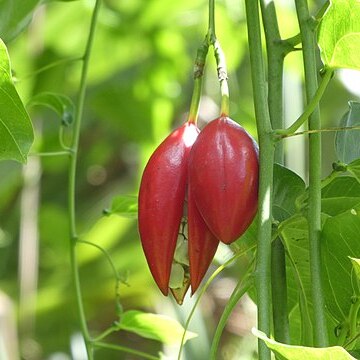Canopy lianas, to 30 m long. Roots fleshy, thickened. Stems terete, to 5 cm in diam.; internodes 2-20 cm; tendrils (3-forked or) simple, to 25 cm. Stipules flattened-triangular, ca. 1 mm; petiole 1-10 cm, glands at blade-petiole junction 2, on concave 2-4 mm in diam. auriculate extensions at apex of petiole in mature leaves, 1-3 mm in diam.; leaf blade ovate to lanceolate, membranous to leathery, glands often present, dotlike, base of mature leaf oblong, unlobed or (2 or)3-lobed with distal 1/3 of leaf often slightly constricted from slight lobation, margin entire to serrate, apex acute to acuminate. Plants (monoecious or) dioecious. Inflorescences often with tendril emerging from center, peduncle to 20 cm, to 40-flowered in males, 2-4-flowered in females; bracts and bracteoles narrowly triangular, ca. 1 mm, apex acute. Pedicel 0.5-13 mm. Flowers tubiform-urceolate, 15-25 × 2-5 mm, including stipe 1-15 mm. Hypanthium urceolate to cupuliform, wall fleshy-leathery, ca. 0.5 mm thick, 3-6 mm deep. Calyx tube 2-3 mm; lobes reflexed, triangular, 1-3 mm, rounded to acute, entire. Petals oblanceolate to triangular, 2-4 × 0.5-1 mm, red punctate, base hastate, apex entire to undulate, rounded to acute. Septa 0.25-3 mm high. Corona absent. Disk glands linear, to 3 mm high, truncate. Male flowers: filaments 1-4 mm, connate up to 2 mm, inserted at base of hypanthium; anthers ca. 3 × 1 mm, acute, up to 0.5 mm apiculate; vestigial ovary ca. 1 mm, gynophore to 1 mm. Female flowers: staminodes 1-3 mm, connate to 1 mm, inserted at base of hypanthium; ovary subglobose to oblong, ca. 4 × 2.5 mm; gynophore ca. 3 mm; style arms ca. 1 mm, free or connate for ca. 0.5 mm; stigmas globose, papillate. Capsules 1-3 per inflorescence, outside deep red at dehiscence, ellipsoid, fruit body to 13 cm, with gynophore to 3 cm, fruit wall leathery. Seeds to 60 per capsule, orbicular; funicles of seeds 5-15 mm. Fl. and fr. throughout year, primarily during wet periods.
Vine to 30 m long; stems terete. Leaves simple to 5-lobed; lamina orbicular, ovate or lanceolate, 5–25 cm long, 2–19 cm wide, apex rounded to acute, base acute to cordate. Tendrils simple, rarely 3-fid, up to 25 cm long. Plants sometimes monoecious with male and female flowers in the same inflorescence. Peduncle up to 20 cm long. Male inflorescences up to 40-flowered; female inflorescences (1–) 2–4 (–8)-flowered. Flowers tubiform to urceolate, borne on a stipe articulated with pedicel, (10–) 15–25 (–30) mm long including stipe, 1.5–7.5 mm wide. Stipe of male flowers 3–15 mm long. Stipe of female flowers 1–6 (–10) mm long. Calyx-lobes triangular, 1–3 mm long. Petals lanceolate, 2–4 mm long. Corona absent. Stamens partially connate into a filament tube. Styles 3 (–5), partially conate. Fruit ellipsoid to oblong-lanceolate, red, pendulous, 2–13 cm long excluding the (0.5–) 1–3 (–4) cm long gynophore, 1.75–4.5 cm wide. Seeds 10–60, orbicular to obliquely triangular.
A slender climber. It grows to 20-30 m long. The stem is square. The leaves are heart shaped tapering to the tip. They are bright green and shiny. There are a few teeth along the edge of the leaf. The leaf is 10-15 cm long by 5-10 cm wide. They have 3 pairs of side veins and a pair of glands at the base of the leaf blade. The plant has long tendrils with a thick hook at the end. The flowers are of one sex but male and female flowers occur on the same plant. The male flower clusters has up to 40 flowers. The female has 1-4 flowers. The flowers are small, green and 0.8 cm across. The fruit is a capsule and narrows towards both ends. It hangs from the vine. It is bright red and turns purple. The fruit is 8 cm long by 3 cm wide. It splits into 3. There are many seeds and they are covered with a white pulp. They occur in rows and are grey.

